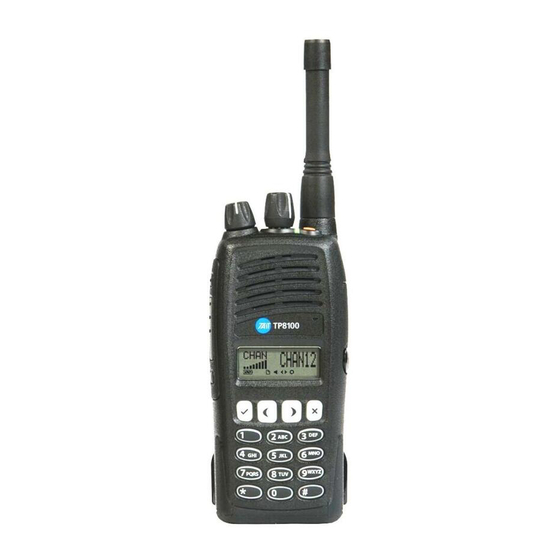
Summarization of Contents
Safety and Compliance
Radio Frequency Exposure Information
Information on FCC RF exposure guidelines for safe usage of the radio.
RF Emission Limits
Details RF emission limits for USA and Canada, and compliance with standards.
Health, Safety, and Environment
European Health and Safety
Covers EU directives on user health, safety, and EMC for radio equipment.
Interference with Electronic Devices
Warns about potential RF interference with aircraft, medical, and other electronic devices.
Hazardous Locations and Safety
Potentially Explosive Atmospheres
Warnings and precautions for using the radio in explosive or blasting areas.
Intrinsically Safe (IS) Radios
Information on IS radio identification, servicing, and approved ratings.
Vehicle Installation and Operation
Radio Installation in Vehicles
Safety warnings regarding airbag areas and proper installation procedures.
Vehicle Charger Operation
Guidelines for installing and operating the vehicle charger.
Radio Modifications and Labels
Unapproved Modifications
Warns against unauthorized modifications that can void compliance.
Attaching Labels
Instructions and warnings for attaching labels to the radio and battery.
Battery Safety
Lithium-Ion Battery Precautions
Warnings about damaged Li-ion batteries causing explosions or fire.
Short-Circuiting Battery Contacts
Cautions against short-circuiting battery contacts to prevent injury.
Charger Compliance
US and Canadian Compliance
Details FCC and IC compliance for the battery charger.
Radio Navigation and Settings
Menu Map Overview
Provides a visual map of the radio's menu structure and options.
Custom Radio Settings
Allows customization of top key, function keys, and shortcut menus.
Getting Started
Before First Use
Essential steps before operating the radio, including battery charging.
Basic Setup Procedures
Covers attaching battery, antenna, and accessories.
Radio Controls and Display
Understanding Radio Controls
Explains the function of PTT, volume, selectors, and keys.
Radio Display and Symbols
Interprets display messages, symbols, and operating modes.
Radio Indicators
Details the meaning of the Status LED and audible tones.
Menu Navigation
Navigating Radio Menus
Guides users through accessing and using the radio's menu system.
Accessing Frequent Menus
Explains using shortcut keys for quick menu access.
Basic Radio Operations
Turning Radio On/Off
Procedures for powering the radio on and off.
PIN Entry
Instructions for entering the personal identification number (PIN).
Volume Adjustment
How to adjust the speaker volume.
Preventing Accidental Calls
Features like keypad lock and PTT lock to avoid unintended operations.
Trunking Operation
Network Availability Check
How to verify if the radio is connected to the trunked network.
Trunking Call Setup
Explains the process of establishing a call on a trunked network.
Making and Receiving Calls
Various methods for initiating and receiving calls, including preset and dialled calls.
Call Security Features
Voice Inversion Scrambling
How to activate and use voice scrambling for unintelligible transmissions.
Call Encryption
Details on encrypting calls for private communication and changing encryption codes.
Call Management
Unconnected Calls
Explains common messages indicating why a call could not connect.
Re-establishing Calls
Using redial, unanswered call, and callback features.
Responding to Missed Calls
Accessing and managing calls stored in the call queue.
Network and Channel Selection
Selecting Trunking Networks
How to change between different trunking networks.
Selecting Control Channels
Manually selecting a control channel using the site select feature.
Advanced Call Types
Preset and Group Calls
Making preset calls and group calls, including membership changes.
Emergency and SOS Calls
Procedures for making emergency and SOS calls for immediate assistance.
Lone Worker Features
Emergency features for lone workers, including man down and motion detection.
Telephone and Data Calls
PABX and PSTN Calls
Making calls to private branch exchanges and public telephone networks.
DTMF Mode Usage
Using DTMF for control codes, telebanking, and automated attendants.
Status and Data Messages
Sending status messages and short data messages (SDMs).
Radio Configuration
Audible Tone Settings
Customizing keypress and audible tones for radio feedback.
Backlighting Control
Turning the display and keypad backlighting on or off.
Display Contrast Adjustment
Adjusting the contrast of the radio display.
Extending Battery Life
Using low power transmit and dynamic power control to conserve battery.
Battery Management
Charger Information
Details on desktop, multicharger, and vehicle chargers.
Battery Handling and Charging
Safe handling, charging procedures, and temperature considerations for batteries.
Battery Life and Storage
Tips for maintaining battery life, cleaning contacts, and proper storage.
Troubleshooting Guide
Radio Power Issues
Steps to resolve problems when the radio does not turn on.
Charger Troubleshooting
Solutions for common charger issues, including LED behavior.
Function Key Customization
Common Function Assignments
Lists functions that can be assigned to top and function keys.
Software License Agreement
Agreement Definitions and Scope
Defines terms and outlines the scope of the software license agreement.
License Grant and Limitations
Details the license grant, restrictions, and IP rights.
Warranty and Transfers
Covers limited warranty, disclaimers, and terms for transferring the software.
Termination and Liability
Outlines termination conditions, limitations of liability, and confidentiality.

















Need help?
Do you have a question about the TP8140 and is the answer not in the manual?
Questions and answers